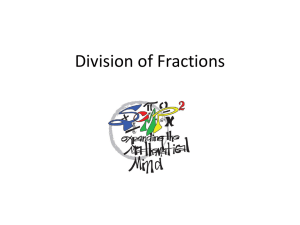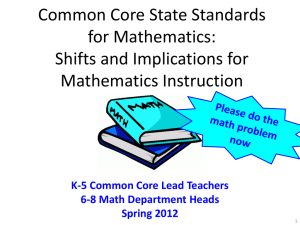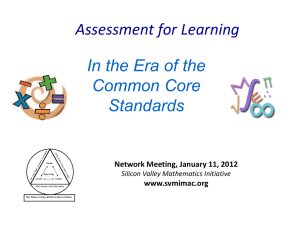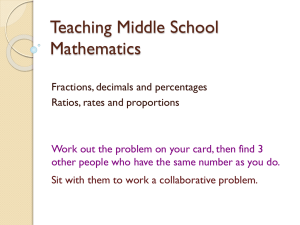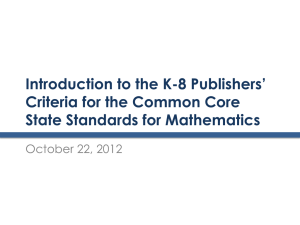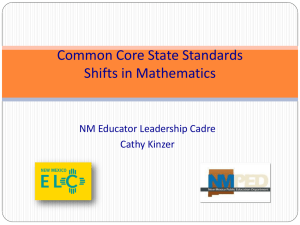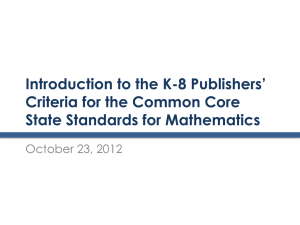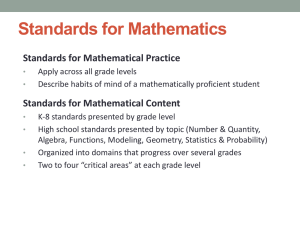Mathematics Progressions – Common Core
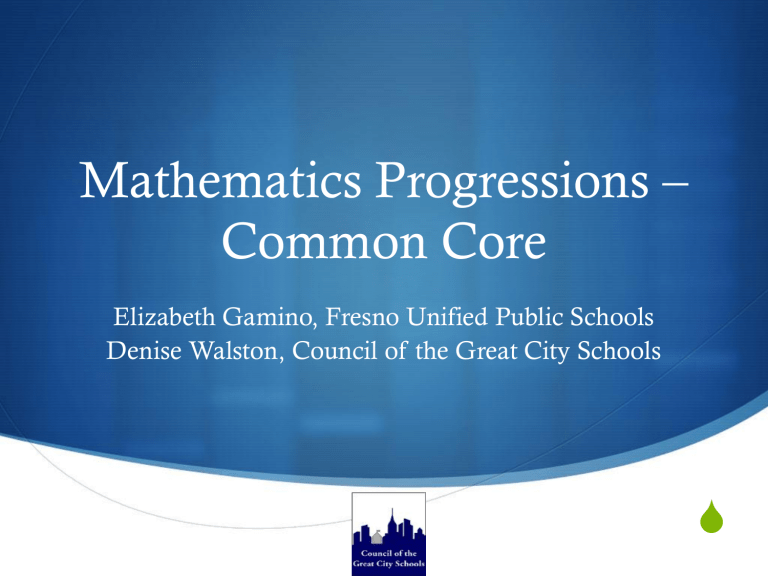
Mathematics Progressions –
Common Core
Elizabeth Gamino, Fresno Unified Public Schools
Denise Walston, Council of the Great City Schools
S
Purpose
S Review and take a closer look at the Mathematics
Progressions
S Focus, Coherence, and Rigor
S Instructional implications
S Scaffolding
S
S
S
S
Explain their thinking; critique the reasoning of others
Developing mathematical arguments
Reading and interpreting real-world problems
Technical language of the discipline
Instructional Shifts
Mathematics
A Look Back
S
Mathematics Instructional
Shifts
S Focus
S Coherence
S Rigor
S
S
S
Conceptual understanding
Procedural skill and fluency
Applications
Focus
S Significantly narrow and deepen the way that time and energy is spent in the math classroom
S
S
Communicate focus so that it is manageable in instruction; it is more than merely writing a standard a day
Focus deeply on those concepts emphasized in the standards
S Provide the time for students to transfer mathematical skills and understanding across concepts and grade levels
S
S
Deep conceptual understanding
Connect conceptual and procedural understanding
S Transitions from concrete ↔ pictorial ↔ language ↔ abstract
Coherence
S Coherence provides the opportunity for students to make connections between mathematical ideas and across content areas
S
S
S
S
Connects the learning both within a grade and across grades
Thinking across grades
Each standard is not a new event, but an extension of previous learning
Allows students to see mathematics as inter-connected ideas
S Mathematics instruction cannot be relegated to merely a checklist of topics to cover, but instead must be centered around a set of interrelated and powerful ideas, rather than a series of disconnected topics
Rigor
S
S
S
Conceptual Understanding
S
S
Involves more than getting the right answer
Access concepts from multiple perspectives
S Transitions from concrete ↔ pictorial ↔ language ↔ abstract
With equal intensity
Procedural Skill and Fluency
S
S
Study algorithms as a way to see the structure of mathematics (organization, patterns, predictability) or apply a variety of appropriate procedure flexibly to solve problems
Students are expected to achieve speed and accuracy with simple calculations (at specific grade levels)
S Fluent is used in the Standards to mean “efficient and accurate”
S Class time and/or homework should be structured for students to practice core functions such as singledigit multiplications
Application
S Expectation that students apply math and choose the appropriate concept for application, even when not prompted to do so
S
S
Apply math concepts in real-world situations
Mathematical modeling
Common Core State
Standards
Mathematics
Closer Look at Fractions S
Fraction Concepts
S Grade One: Partition circles and rectangles into two and four equal shares, describe the shares using the words halves, fourths, and quarters, and use the phrase half of, fourth of, and quarter of. Describe the whole as two of or four of the shares.
Understand for these examples that decomposing into more equal shares creates smaller shares.
Fraction Concepts
S Grade Two same
Partition circles and rectangles into two, three, or four equal shares, describe the shares using the words halves, thirds, half of, a third of, etc., and describe the whole as two halves, three thirds, four fourths. Recognize that equal shares of identical wholes need not have the shape.
Coherence – strengthens foundations
S Progression involving fractional concepts (conceptual understanding) and operations (multiplication and division of fractions):
S Grade Three:
S Grade Four:
Develop understanding of fractions as numbers
Develop understanding of fractions as part of a whole and as a number on the number line
Explain equivalence of fractions in special cases, and compare fractions by reasoning about their size
Extend understanding of fraction equivalence and ordering
Build fractions from unit fractions by applying and extending previous understandings on whole numbers
(decompose a fraction into a sum of fractions with the same denominator)
Coherence: Number and
Operations - Fractions
S Grade Four:
S Grade Five:
S Grade Six:
Multiply a fraction by a whole number
Multiply a fraction by a fraction
Divide unit fractions by a whole number; and whole numbers by unit fractions
Interpret and compute quotients of fractions and solve word problems
The Mathematics
Progressions
Developing a deep understanding of focus, coherence, and rigor
S
•
•
•
Mathematics Progressions
Common Core State Standards in Mathematics
•
•
Informed by research on children’s cognitive development and the logical structure of mathematics
Narrative documents
Progression of concepts across several grade bands
Closer Look – Fraction Progression
Fraction as number
Linking content to the
Mathematical Practices
and
District Perspective
S Read and analyze the progressions (book study, close read)
S Through the lens of focus, coherence and rigor
S Need to look at the standards in their entirety K-12
S Determine what happens prior to students entering your door and where they need to go - beyond the grade level below and above.
Problems for consideration
Exploring the Fraction Progression using illustrative tasks
S
Questions to consider
S What are some things that you had to attend to?
S What are some things that ELLs need to be aware of ?
S What are the implications for planning for instruction?
S How might you assess student understanding specifically related to ELLs?
S What are the implications for professional development?
Online Resources
Fraction Professional Development Module
S
Fraction Progression Online
Module
S Goals/Purpose:
S
S
S
Deepen educators content knowledge, specifically around the mathematics “Fractions” progression;
Engage practicing educators in the development of CCSS-aligned professional development; and
Provide consistent, high-quality professional development that can be used at large scale and online across PARCC states to inform elementary teachers and instructional leaders
S Partnership with CGCS, Institute for Mathematics & Education,
University of Arizona, and Achieve
Design within Edmodo
S Features of the module
S
S
S
S
S
S
S
Online and interactive
Based on a framework developed collaboratively with CGCS
Illustrative of the Fractions Progression in the CCSSM
Seven units anchored by a 3-5 minute video
Three to four illustrative tasks associated with the progression
Built-in, interactive checks for understanding
Interactive-check for understandings – Quiz – linked to the commentary
Online Professional
Development Module
S http://commoncoreworks.org/domain/121

